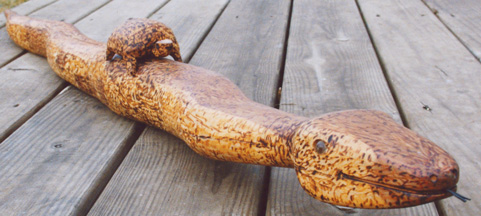
Magazine
Winter/Spring 2002
 Collaboration
Collaboration
A story from a sculptor’s
encounters with artists in Appalachia
by Doug Calisch
The guy at the gas station told me I’d find Troy’s house up
the gravel road and to the right, but even when I got there, I wasn’t
sure it was the right place. An elderly woman was working in the front
yard. I knew I had about 30 seconds to convince her that I wasn’t
a tax collector or an encyclopedia salesman. My black lab, Wiley, helped.
The woman was interested in my dog, and she noticed my camera.
“I’m a carver,” I told her. I said I’d heard of an
artist who lived nearby and I wanted to talk with him about his work.
“That would be my husband,” she said. And she called out to
Troy and told him I was coming up to the house.
He was a short, wiry man who’d lost his leg in a coal-mining accident.
Almost emaciated from stomach cancer that afflicted him, he didn’t
look strong enough to walk to the tiny, unheated shed where he worked.
But he lived for that work. He’d struggle out to that shed and start
to sing, working lengths of red cedar with old reconditioned or makeshift
tools, some crusted with rust, to shape a menagerie of stylized creatures.
Under the light of a bare bulb, sometimes in air so cold you could see
your breath, he pressed a woodburner over and over on his carvings, imprinting
each with an elaborate pattern. The pieces were beautiful.
He offered me a sun tea, opened one for himself, and we talked about our
respective projects. I described how I created sculptures from objects
I collected.
“And you’re an artist up there in the north?” he asked.
I nodded
“And people there like that?” he asked.
“Seems like it,” I said.
Snakes and turtles were prominent in Troy’s created menagerie. The
four-foot long snakes were fashioned from cedar branches—a fitting
use for the twisting wood. Many people in the valley feared snakes, the
serpents of the Genesis story taken literally by most there, including
Troy himself. Some of his snakes hung in homes, a talisman to ward off
evil.
The turtles were another matter.
“Turtles are wanderers, but they always return home,” Troy explained.
They lay their eggs in the same place every year, he said. They were a
symbol of nomad—but the nomad connected.
He named each of the turtles after his grandkids, with hopes that his
descendants would leave the valley and prosper, but would always return
home.
I didn’t have those stories in mind when I saw Troy’s turtles
and snakes in his house. My trained eye saw only how their size and shapes
fit together almost like a puzzle, though that had not been Troy’s
intention.
“What if we created a mystical creature together,” I suggested,
catching him off guard. “A snake with the turtle riding on his back?”
Troy thought about it. We went back to the shed, took a couple of snakes
and three turtles, and talked for a long time before we started working
together. Troy was concerned that, with turtles and snakes being such
strong symbols in the valley—symbols with plenty of stories behind
them—a turtle riding a snake might just confuse people. I said that,
for me, that was the point. People ought to be able to make up their own
stories.
Once we’d worked through the artistic concepts, we finished the piece
in only an hour or so. I liked the result, and I offered to buy it from
him. Troy obliged, simply adding up what he usually charged for a turtle
and snake. The hours we talked and worked together were a gift.
A few weeks after I got home, I wrote to Troy and asked him if there was
anything he could use from “up north.” The red cedar he prized
for his carving was hard to find in his valley, so I shipped him some.
His life and work were still inspiring me, and still inform my art; it
seemed only right that I send him something he could use for a while,
too.
Doug Calisch is professor of art at Wabash.
See works from Calisch’s “Visualized Epilogues” exhibit in this issue's Faculty Gallery.
Return to the table of contents
